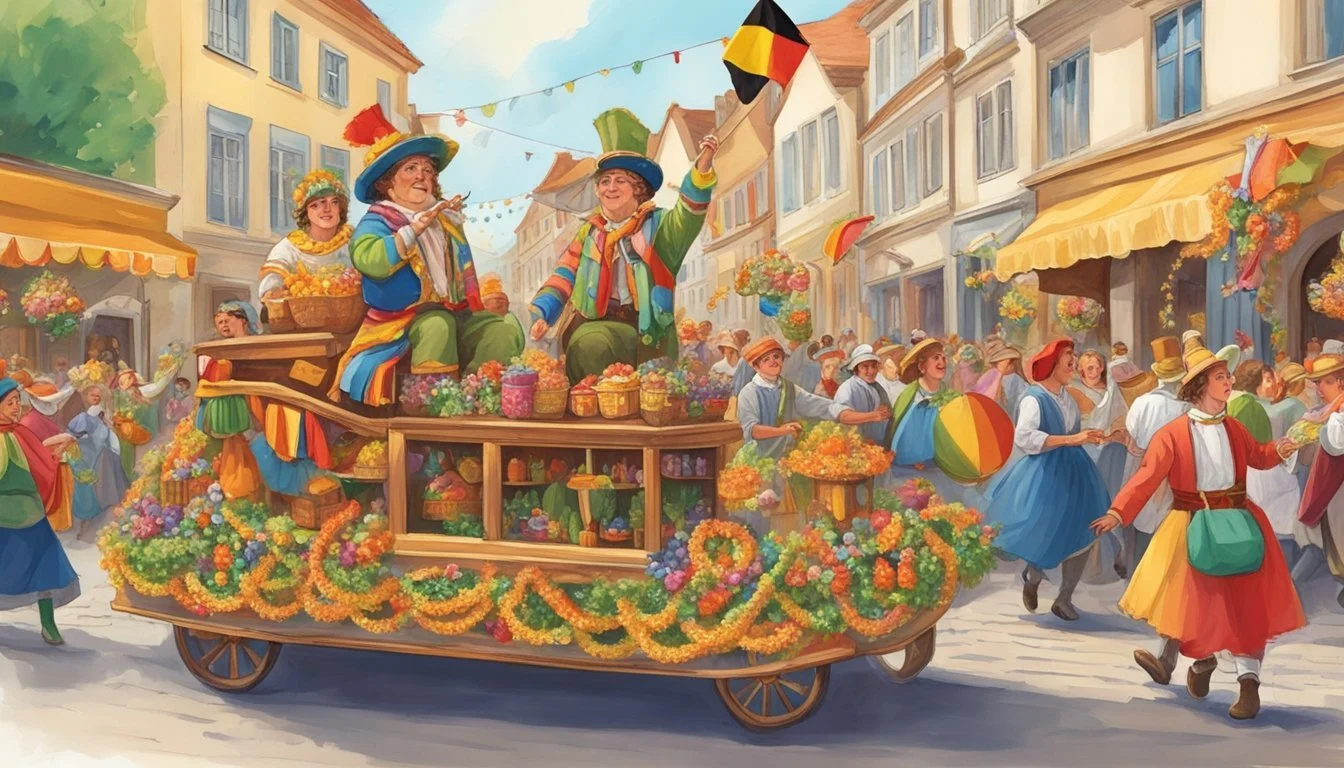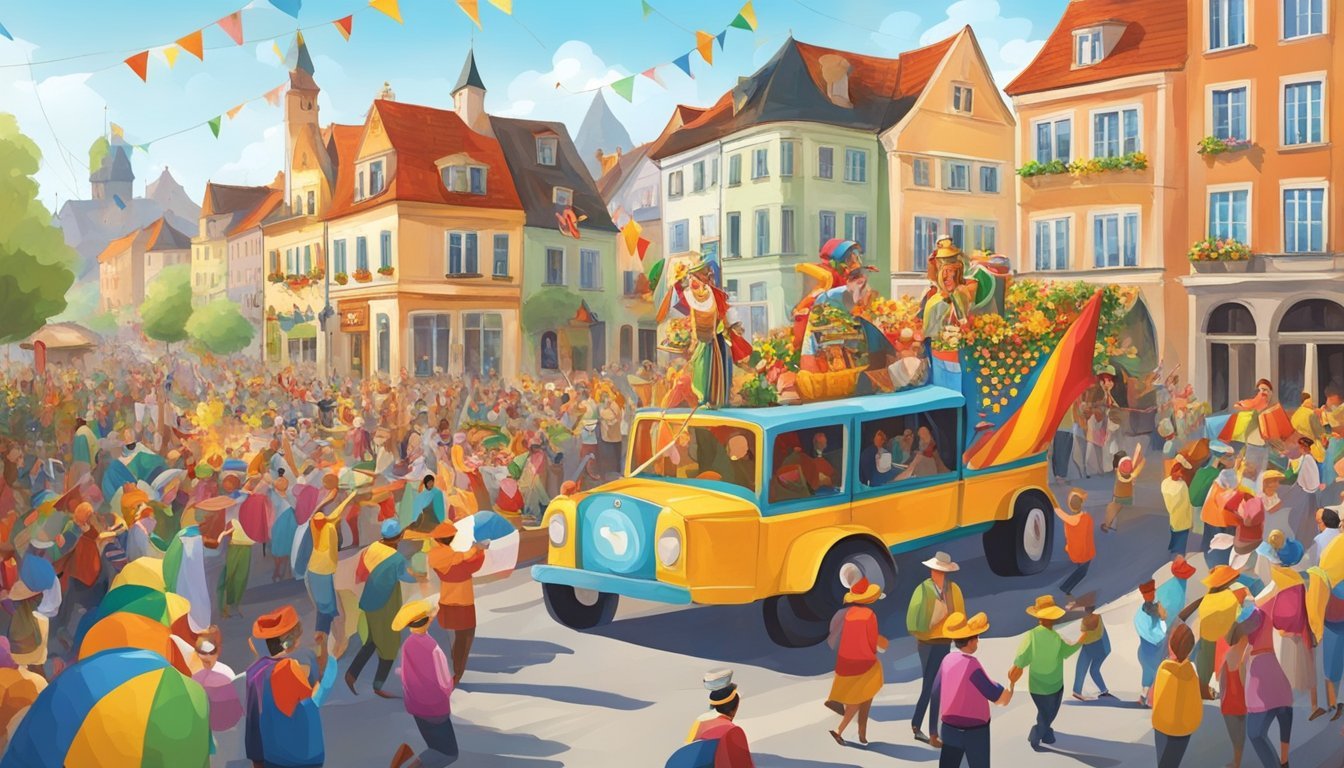German Texan Traditions for Karneval
Celebrating with a Unique Cultural Twist
In the cultural melting pot of Texas, German Texan communities celebrate Karneval, also known globally as Carnival, with a unique blend of traditions. These festivities echo the customs of their ancestral homeland, adapted to the Lone Star State's diverse culture. They combine the conventional revelry of German Fasching with local flavors, creating celebrations that are as vibrant as they are culturally rich.
German Texans inherit a legacy of Karneval celebrations that traditionally precede the solemn period of Lent in the Christian calendar. This festive season, known in Germany as the "fifth season," typically includes a variety of events such as parades, masquerade balls, and humorous skits that provide a platform for social commentary. While the grandeur may differ from the large-scale events of Germany's Rhineland, the community spirit and the foundational customs remain deeply rooted in Texas' local festivities.
Known for their strong preservation of heritage, German Texans integrate aspects like the Narrenschelte, where jesters playfully chide community members in a light-hearted roast, and effigy ceremonies that mark the end of the celebration. Traditional German costumes, music, and dances are reimagined with a Texan twist, illustrating the interplay between historical tradition and contemporary Texan culture. The embodiment of this cultural fusion is evident in public gatherings and private parties during the Karneval season, ensuring that the essence of the celebration thrives in the heart of Texas.
History and Origins
Karneval has its roots deeply embedded in ancient traditions and has undergone significant transformation over the centuries. It embodies a rich tapestry of cultural significance in Germany, melding pagan customs with Christian beliefs, and has found a unique expression among German Texans who strive to preserve their heritage.
From Pagan Rituals to Christianity
The origins of Karneval can be traced back to pagan rituals that celebrated the end of winter and the coming of spring. Ancient festivities involved masquerades and feasting as a way to chase away winter spirits and welcome fertility with the advent of spring. With the spread of Christianity, these practices were integrated into the Christian calendar. The term Karneval is believed to derive from the Latin carne vale, which means "farewell to meat," signifying the onset of the fasting period of Lent.
The Evolution of Karneval in Germany
Throughout the Middle Ages, these celebrations transformed into a public festivity in Germany, with features that are still recognizable today. The German Karneval evolved to include parades, elaborate costumes, and masked balls, providing a release valve for society's rigid norms before Lent's austerity. Different regions in Germany embraced the festival with varying customs, reflecting the diverse facets of German culture.
German Texans and Cultural Preservation
As German immigrants settled in Texas, they brought with them their festive traditions, including Karneval. German Texans have maintained these heritage celebrations as a testament to their cultural preservation. They merge traditional German elements with local Texan influences, illustrating a living history that continually evolves while honoring its foundational origins.
Carnival Season and Festivities
In the heart of the German-Texan community, the Carnival Season is a rich display of cultural heritage blending traditional German celebrations with local Texan influences. It kicks off annually on November 11, symbolizing the start of a period filled with vibrant parades, colorful costumes, and social festivities leading up to Ash Wednesday and the beginning of Lent.
The Fifth Season
The "Fifth Season," as it is colloquially known, is a whimsical term for the Carnival Season. It starts each year at precisely 11:11 AM on November 11th and extends until the stroke of midnight before Ash Wednesday. It's a time when the ordinarily reserved German-Texan community erupts into a period of merriment and public revelry.
Karneval vs. Fasching vs. Fastnacht
These three terms refer to the Carnival traditions in Germany with slight regional variations that the German-Texan community honors:
Karneval – Predominantly celebrated in the Rhineland, reflecting more flamboyant festivities.
Fasching – Commonly linked with Bavaria and Austria, with a focus on masquerade balls and dances.
Fastnacht – Associated with the southwestern region of Germany, often signifies more traditional and even somber events.
Opening Ceremonies
In line with the German tradition, the opening ceremonies in German-Texan communities are a spectacle. They often include the proclamation of the Carnival Prince and Princess, who preside over the festivities and the symbolic "storming" of local city halls, signifying the taking over of the town by merrymakers.
Key Dates of the Carnival Season
Here are the pivotal dates and events during the Carnival Season for the German-Texan community:
November 11th, 11:11 AM: The official start to the Carnival Season with celebrations in community centers and public squares.
Weiberfastnacht: The Thursday before Ash Wednesday, known for women's carnival celebrations.
Rosenmontag (Rose Monday): The highlight of the season with large parades and street parties.
Fastnacht/Faschingsdienstag: Shrove Tuesday, the close out to the festivities with more informal gatherings.
Ash Wednesday: Marks the end of Carnival and the beginning of Lent, a time for reflection and fasting.
Cultural Expressions
The celebration of Karneval in German Texan communities showcases a rich tapestry of cultural expressions, where traditional roles and characters come to life through elaborate costumes and masks, and the air is filled with the sounds of music and performances unique to this festive time.
Roles and Characters
Characters like the Jester, known for their satirical speeches and humorous antics, play a crucial role in the cultural fabric of Karneval. The Prinzenpaar (Prince and Princess) represent a form of carnival royalty, leading many of the festivities and embodying the jovial spirit of the season.
Costumes and Masks
During Karneval, individuals don vibrant costumes and masks that range from whimsical to satirical, often reflecting regional folklore and historical figures. These outfits are not just for show but serve as a disguise, allowing revelers to partake in the festivities with a sense of anonymity and freedom.
Types of Costumes:
Traditional Folk: Reflecting German heritage.
Satirical: Commenting on contemporary issues.
Music and Performances
Music is integral to Karneval, with a variety of performances that include brass bands playing traditional tunes, modern music, and classic Karneval songs that many will sing along to. The performances during the parade and other events typically feature both humor and skill, with participants often rehearsing for weeks in advance to deliver memorable entertainment.
Performance Highlights:
Brass Bands: A staple musical element.
Dance Routines: Often telling a story or celebrating local culture.
Traditional Events and Activities
Celebrating German Texan traditions, Karneval brings a blend of cultural festivities that are rooted in German customs. Key events like Rose Monday and Weiberfastnacht mark the high points of this festive season, characterized by parades, humor-laden speeches, and playful pranks.
Rose Monday (Rosenmontag)
Rose Monday stands as the climax of the German Karneval season, with activities reaching their peak. On this day, parades meander through streets with floats that often carry a satirical edge, poking fun at political and social issues.
Weiberfastnacht (Women’s Carnival)
Weiberfastnacht signifies the start of the Karneval weekend, where women traditionally take control. They congregate in public spaces, snipping ties off men as a symbolic act of asserting power, and local governments are symbolically taken over.
Parades and Floats
Karneval parades are grand spectacles, featuring a diverse array of intricate floats designed to amaze onlookers. Participants dress in elaborate costumes, and these parades serve as a canvas for artistic and satirical expression.
Büttenrede (Speeches) and Pranks
Büttenrede, the art of carnival speeches, are delivered with a sharp tongue, filled with satire and wit. Pranks are commonplace during Karneval, infusing the atmosphere with laughter, as participants indulge in light-hearted mischief and playful antics.
Food and Delicacies
German-Texan traditions during Karneval center around a vibrant array of foods and drinks that reflect a fusion of German and Texan cultures. Festivalgoers find delight in hearty meats, indulgent pastries, and refreshing beverages.
Traditional Eats
A centerpiece on the Karneval menu is meat—often seasoned, grilled, and enjoyed with gusto. One iconic dish that satisfies both German and Texan palates is the Currywurst; a grilled sausage sliced and generously topped with curry-infused ketchup. Meat is a staple, appearing in a variety of forms from sausages to schnitzels, all cooked to perfection and capturing the spirit of indulgence before Lent.
Karneval Pastry
Karneval wouldn't be the same without its traditional pastries. One must-try is the Berliner, sometimes known as Krapfen. This sweet, doughnut-like treat is commonly filled with jam and dusted with sugar, serving as a delightful counterpoint to the savory flavors of the meats.
Berliner:
Also known as: Krapfen
Fillings: Typically jam, often apricot or raspberry
Coating: Powdered sugar or granulated sugar
These pastries are a beloved part of the gastronomic celebration, and their presence echoes the shared German heritage.
Beverages
To complement the rich flavors of the food, beer is the beverage of choice and is deeply ingrained in both German and Texan cultures. Various types of beer—from crisp lagers to robust ales—are enjoyed in the spirit of Karneval, providing a refreshing balance to the hearty fare.
Beer Varieties at Karneval:
Lagers
Ales
Pilsners
Bocks
These beverages, served cold, are not only thirst-quenchers but also integral to toasting to good health and festive cheer during the celebrations.
Social and Cultural Impact
The Karneval celebrations in German Texan communities affirm their rich cultural history and encourage social cohesion through festive events that showcase both respect for traditions and support for diversity.
Community and Identity
Karneval serves as a pivotal occasion for German Texans to express their identity and reinforce community bonds. Support for local customs is evident as residents, irrespective of their age, don costumes representative of their heritage. This yearly convergence is a display of respect for cultural roots, allowing new generations to feel a comfort and familiarity with their past. The festival becomes a symbol of creativity, with native folklore depicted in parades and costumes, alongside modern interpretations that tolerate and embrace a confluence of cultures.
It promotes unity.
It offers an opportunity to display cultural pride.
Karneval's Role in Modern Society
In today's society, Karneval reaches beyond traditional bounds to act as a platform for diversity and cross-cultural exchange. The celebrations provide a space where tolerance and support for different cultures are not just preached but practiced. Through the lens of Karneval, German Texans showcase to the wider society the possibility to maintain one's cultural heritage while still being part of a diverse and vibrant modern fabric.
Inclusion of different groups highlights societal diversity.
Fostering creativity in cultural expression impacts broader society.
Conclusion
The German Texan community holds on to its rich heritage by celebrating Karneval with enthusiasm and authenticity. They carry forward a tapestry of memories tied to old-world festivities, and in doing so, they foster a cultural continuity that spans continents and generations. This cultural festivity serves as a bridge connecting their German roots with Texan life.
Within these communities, Karneval is recognized not merely as a period of revelry but as a ritual of cultural expression. Traditional German costumes emerge from family trunks, each stitch and color telling stories of heritage and festivity.
Parades & Festivities: Vibrant parades reminiscent of those in Cologne become a visual spectacle.
Culinary Delights: Tables boast an array of German-Texan culinary treats, combining the hearty flavors of Texas with the time-honored recipes of Germany.
Music & Dance: Polka melodies and folk dances inspire camaraderie and festivity among community members of all ages.
Karneval provides an essential communal space for German Texans — they renew bonds, partake in collective joy, and preserve their ancestors' spirit through song, dance, and shared laughter. These annual celebrations leave a lasting imprint on the collective identity of German Texans, ensuring that the customs and stories that define them continue to resonate year after year.





